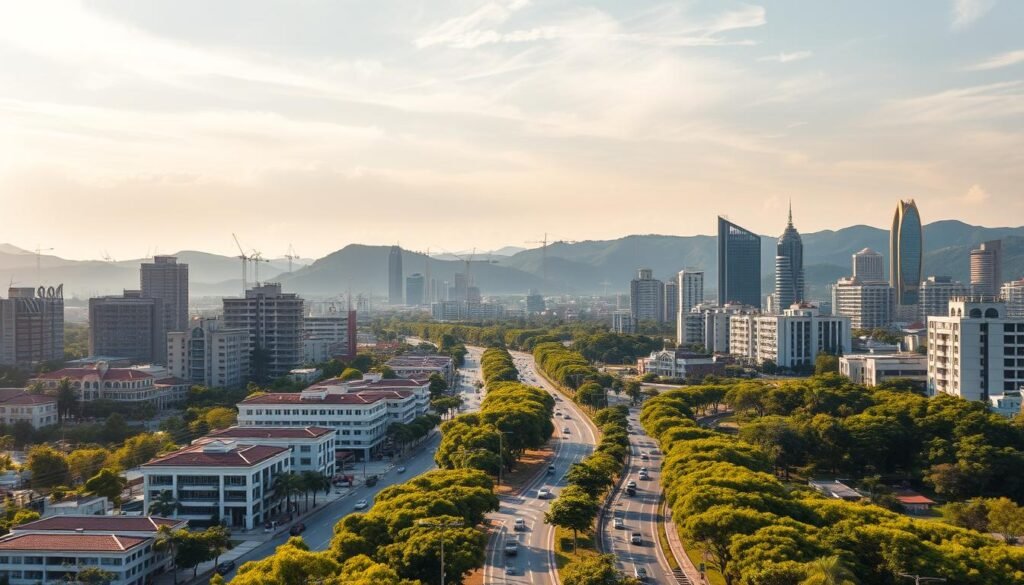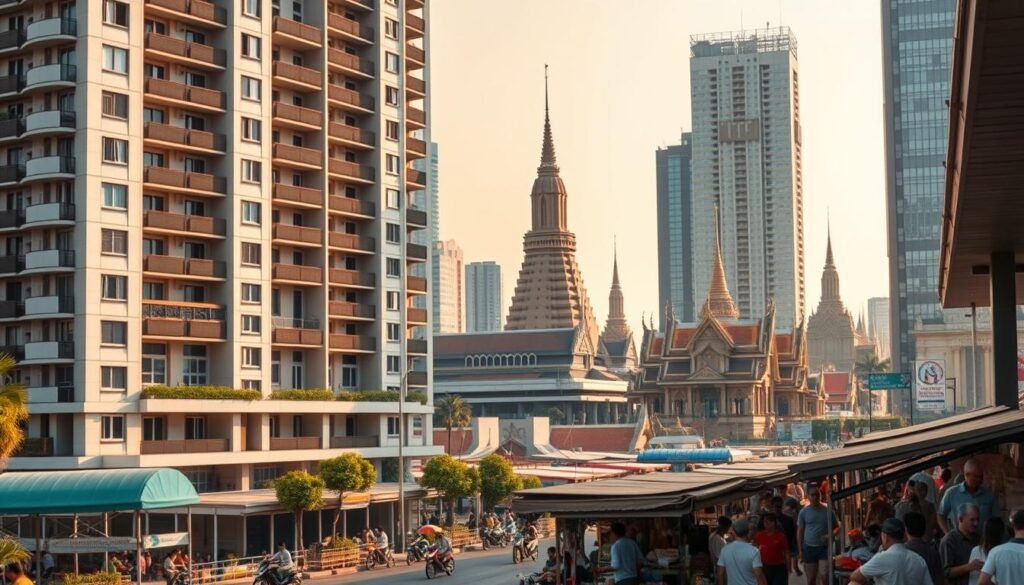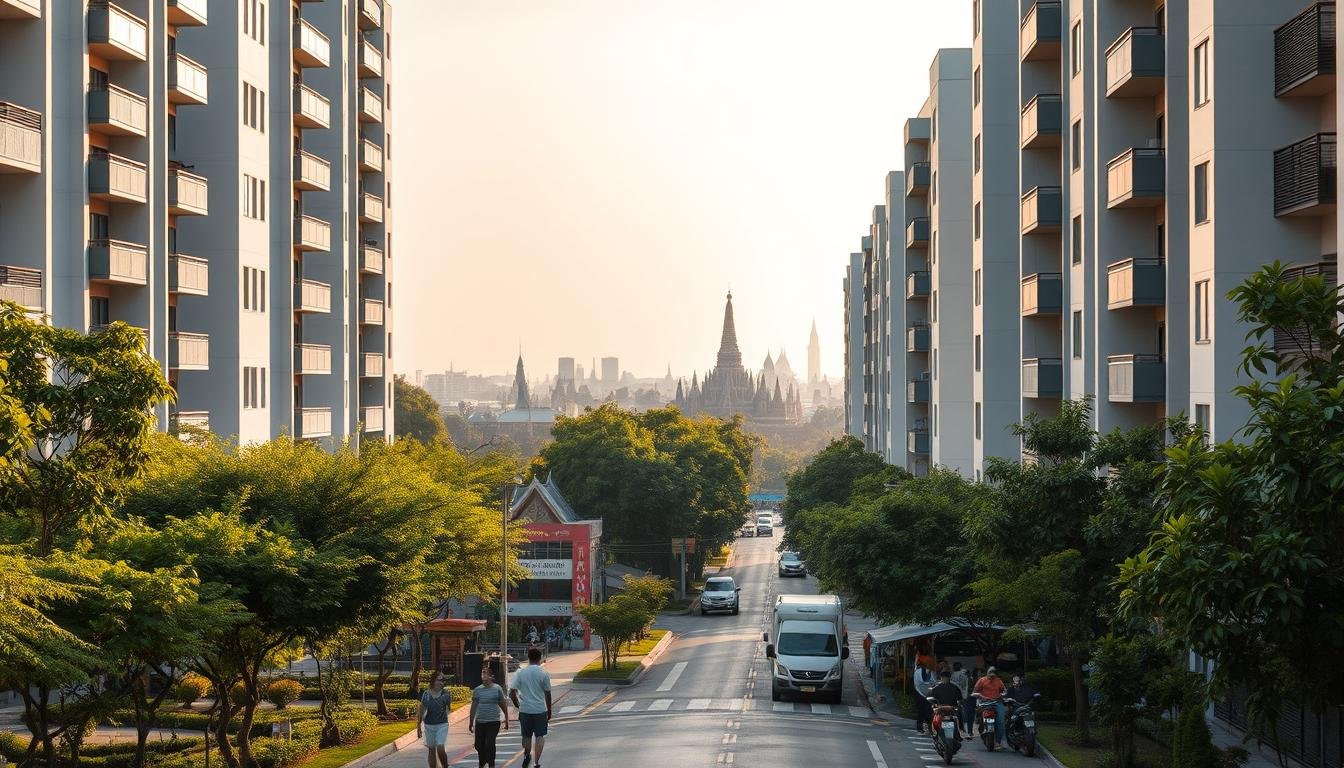Cambodia’s real estate market is catching the eye of investors around the world. This is because of its robust economic growth and fast urbanization. Knowing how to check rental yields in this market is key for smart investment choices.
Thinking about investing in Cambodia’s real estate? Its economy is growing fast, thanks to tourism, manufacturing, and new infrastructure. Figuring out the return on investment (ROI) in Cambodia’s homes can be tricky. But it’s vital for making your investment pay off.
Key Takeaways
- Understanding Cambodia’s economic growth drivers is key for rental yield evaluation.
- Urbanization plays a big role in Cambodia’s real estate market growth.
- Checking ROI is essential for making smart investment choices in Cambodia’s homes.
- Cambodia’s home market could offer high rental yields.
- It’s important to look at local market trends for successful investing.
Understanding Rental Yields in Cambodia’s Property Market
Investing in Cambodia’s property market? Knowing about rental yields is key to making the most of your investment. Rental yields show how much income a property makes compared to its value.
What Are Rental Yields and Why They Matter to Investors
Rental yields are the annual income from a property as a percentage of its price or value. This is important for investors because it shows how well a property can make money. A higher yield means a better investment, but remember to look at other factors too.
Gross vs. Net Rental Yields: Critical Distinctions
It’s important to know the difference between gross and net rental yields. Gross yield doesn’t subtract any costs, while net yield does. For example, a $100,000 property might have a 8% gross yield but only 6% net yield after expenses.
Understanding these differences helps you make better investment choices. You can learn more by checking out Phnom Penh real estate case studies.
Cambodia’s Yield Performance Compared to Southeast Asian Markets
Cambodia’s rental yields are compared to other Southeast Asian markets. This helps see how competitive they are. Recent data shows Cambodia’s yields are strong, thanks to places like Siem Reap and Sihanoukville.
| City | Average Gross Rental Yield |
|---|---|
| Phnom Penh | 6-8% |
| Siem Reap | 7-9% |
| Sihanoukville | 8-10% |
| Bangkok | 4-6% |
| Kuala Lumpur | 3-5% |
Cambodia’s cities have higher rental yields than many other Southeast Asian cities. This makes them great for investors looking for good returns. Experts say Cambodia’s tourism and infrastructure growth help it stand out in rental yields.
Current Overview of Cambodia’s Residential Market
The residential property market in Cambodia is changing fast. Phnom Penh is leading this change. It’s becoming a key spot for both local and foreign investors.
Phnom Penh’s Evolving Property Landscape
Phnom Penh is growing a lot, thanks to infrastructure development and urbanization. The property market is getting more complex. There are many new developments and projects.
Some areas to keep an eye on include:
- The expanding CBD, with new office spaces and luxury condominiums
- Up-and-coming neighborhoods with affordable housing options
- Renovated historic districts, blending old and new
Emerging Hotspots: Siem Reap, Sihanoukville, and Kampot
Other cities are also catching the eye of investors. Siem Reap is famous for its culture and is seeing more boutique hotels and serviced apartments. Sihanoukville is turning into a beach hotspot with new resorts and condos. Kampot is drawing those who want a relaxed, natural life.

How Recent Infrastructure Projects Impact Rental Demand
New roads and public transport have changed the game. They make it easier to get around, making different areas more appealing. This has made rental yields in Cambodia more attractive, with a strong ROI for investors.
It’s key for investors to understand these changes. By keeping up with the latest news and trends, you can make better investment choices.
How to Calculate Rental Yields in Cambodia
To understand the return on investment (ROI) in Cambodia’s property market, knowing how to calculate rental yields is key. This process includes several important steps. These steps help investors make smart choices about their property investments.
Gathering Accurate Property Price Data
The first step is to gather accurate property price data. You need to research recent sales of similar properties in your area. Look at local real estate agents, online portals, or do your own research to find your property’s market value.
For example, if you’re thinking about a condominium in Phnom Penh, check the prices of recently sold units. This information is the base for your yield calculations.
Determining Realistic Rental Income Expectations
The next step is to figure out the rental income you can expect. Research the local rental market to see what similar properties are renting for. Consider the property’s location, amenities, and the demand for rentals.
For instance, a studio apartment in Siem Reap might get more rent than a similar one in a less popular area. Talk to local property managers or agents to get a realistic income estimate.
Accounting for Cambodia-Specific Expenses and Taxes
Cambodia has specific costs and taxes for investors to consider when calculating rental yields. These include property taxes, maintenance, and management fees. Knowing these costs is essential for accurate yield calculations.
Property taxes in Cambodia are low, but management fees can differ based on the company. Also, plan for maintenance costs to keep your property in good shape.
Computing and Interpreting Your Final Yield Figures
With all the data in hand, you can calculate your rental yield. Divide the annual rental income by the purchase price and express it as a percentage. This gives you your gross rental yield.
To see your actual ROI, calculate your net rental yield. Subtract expenses and taxes from your rental income. This will show you your real return in Cambodia’s property market.
Key Factors Affecting Rental Yields Cambodia
Investors in Cambodia need to know what affects rental yields. Several important factors come into play when investing in residential property.
Location Analysis: District-by-District Yield Comparison
Location is key for rental yields in Cambodia. Different areas in Phnom Penh and other cities have different yields. This depends on things like being close to business centers, amenities, and infrastructure.
- Central business districts tend to offer lower yields due to high property prices.
- Up-and-coming neighborhoods may provide higher yields as they develop.
- Tourist areas can command high rents, thanks to their popularity.
Property Types: Condominiums vs. Shophouses vs. Villas
The type of property you choose greatly affects rental yields. Condominiums, shophouses, and villas appeal to different people and offer different yields.
Condominiums are popular with expats and young professionals, providing stable yields.
Shophouses can offer higher yields, if used for business.
Villas are often chosen by families and can get high rents, thanks to their location in gated communities.

Tenant Demographics: Expats, Locals, and Digital Nomads
The type of tenant affects rental yields. Knowing the local market is essential.
- Expats often seek furnished apartments in central areas.
- Locals prefer more affordable, spacious options.
- Digital nomads look for short-term rentals with good amenities.
Seasonal Variations and Tourism Impact on Short-Term Rentals
Cambodia’s tourism industry greatly affects short-term rental yields, mainly in Siem Reap and Sihanoukville.
Seasonal changes impact how often places are rented out. Peak tourist seasons mean higher rents but more competition.
- Peak season (November to March) has higher occupancy.
- Low season may need lower prices to attract renters.
Practical Investment Strategies for UK Investors
UK investors aiming to profit from Cambodia’s growing housing market need to know a few key strategies. It’s important to understand the local market and the rules that govern it. This knowledge helps make smart investment choices.
Navigating Foreign Ownership Restrictions and Solutions
Foreigners face challenges when buying property in Cambodia. They can’t own land, but they can buy condos. Knowing the Cambodian Condominium Law is key. This law lets foreigners own units in buildings, opening up investment opportunities.
Currency Risk Management Between GBP, USD, and KHR
Managing currency risks is critical when investing in Cambodia. Changes in GBP, USD, and KHR can affect your earnings. Tools like forward contracts or currency options can help manage these risks.
| Currency | Exchange Rate Risk | Mitigation Strategy |
|---|---|---|
| GBP/USD | High | Forward Contracts |
| USD/KHR | Medium | Currency Options |
Building a Reliable Local Management Team
Having a good local team is essential for managing your property well. This team should include property managers, lawyers, and accountants who know Cambodian laws.
Due Diligence Checklist for Remote Investors
For UK investors managing properties from a distance, a detailed checklist is vital. It should cover checking property titles, understanding local market trends, and following Cambodian laws.
By using these practical strategies, UK investors can successfully invest in Cambodia’s housing market. They can achieve a good return on their investment.
Conclusion
Exploring Cambodia’s residential market shows how important rental yields are. Knowing what affects them, like location and tenant types, helps improve your investment returns. This knowledge is key to success in Cambodia’s property market.
Cambodia’s real estate market is full of chances for investors. Cities like Phnom Penh and Siem Reap are growing fast. To make the most of these chances, you need to carefully look at rental yields.
Following the steps in this article can help you make smart choices. It’s about maximizing your returns in Cambodia’s property market. Remember, rental yields are key to reaching your investment goals.
Cambodia’s growing economy and housing demand make it a great spot for UK investors. Understanding rental yields in Cambodia can help you tap into this market’s full power. This way, you can get a strong return on your investment.
FAQ
What is a good ROI for a residential property in Cambodia?
In Cambodia, a good return on investment (ROI) for homes is 4-8% each year. This depends on where the property is, its type, and how it’s managed. For example, condos in Phnom Penh’s center often earn more than those outside the city.
How do rental yields in Cambodia compare to other Southeast Asian countries?
Cambodia’s rental yields are quite competitive with other Southeast Asian countries. Yields in big cities like Phnom Penh are similar to Bangkok or Kuala Lumpur. But, places like Siem Reap and Sihanoukville offer higher yields because of growing tourism.
What are the typical expenses associated with owning a rental property in Cambodia?
Owning a rental property in Cambodia comes with usual costs. These include property management fees, upkeep, taxes, and insurance. Don’t forget Cambodia-specific costs like land registration fees and transfer taxes when figuring out your net rental yield.
How do I manage currency risk as a UK investor in Cambodia’s residential market?
To handle currency risk, think about hedging strategies like forward contracts or currency options. Keeping a local currency account in Cambodian Riel (KHR) or US Dollars (USD) can also help with exchange rate changes.
What are the key factors to consider when evaluating rental demand in Cambodia?
When looking at rental demand, think about location, property type, and who might rent it. Also, check on local projects, tourism trends, and seasonal changes to see if rental income might grow.
How can I ensure compliance with Cambodian regulations as a foreign property owner?
To follow Cambodian rules, work with a trusted local lawyer or property expert. They can help with foreign ownership rules and registration needs. Make sure to register your property and get the right permits.
What is the average rental yield for condominiums in Phnom Penh?
Condos in Phnom Penh usually earn 5-7% each year, based on location, age, and amenities. Luxury condos in top areas might earn less than mid-range ones.




